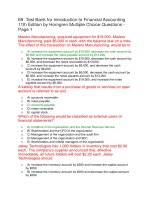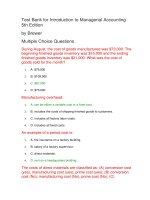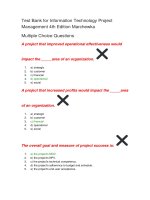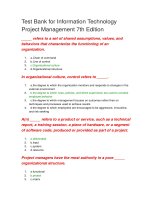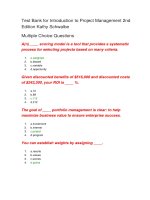Test bank for introduction to project management 2nd edition kathy schwalbe
Bạn đang xem bản rút gọn của tài liệu. Xem và tải ngay bản đầy đủ của tài liệu tại đây (105.04 KB, 18 trang )
Test Bank for Introduction to Project Management 2nd
Edition Kathy Schwalbe
Multiple Choice Questions
A(n) ____ scoring model is a tool that provides a systematic process for
selecting projects based on many criteria.
1.
a.weighted
2.
b.biased
3.
c.variable
4.
d.opportunity
Given discounted benefits of $516,000 and discounted costs of $243,200,
your ROI is ____ %.
1.
a.10
2.
b.89
3.
c.112
4.
d.212
The goal of ____ portfolio management is clear: to help maximize
business value to ensure enterprise success.
1.
a.investment
2.
b.interest
3.
c.project
4.
d.program
You can establish weights by assigning ____.
1.
a.results
2.
b.values
3.
c.scores
4.
d.points
____ period is the amount of time it will take to recoup—in the form of net
cash inflows—the total dollars invested in a project.
1.
a.Return
2.
b.Payback
3.
c.Accrual
4.
d.Residual
If you create the weighted scoring model in a spreadsheet, you can enter
the data, create and copy formulas, and perform a “____” analysis.
1.
a.scenario
2.
b.query
3.
c.what-if
4.
d.hypothetical
Studies show that one of the main reasons people quit their jobs is
because ____.
1.
a.there is too much risk
2.
b.they feel they do not make enough money
3.
c.they feel they do not make a difference
4.
d.they feel overworked
____ are new requirements imposed by government, management, or
some external influence.
1.
a.Directives
2.
b.Problems
3.
c.Opportunities
4.
d.Thresholds
An organization can view project portfolio management as having ____
levels, from simplest to most complex.
1.
a.two
2.
b.five
3.
c.six
4.
d.ten
Payback occurs in the year when the cumulative benefits minus costs
reach ____.
1.
a.($1400)
2.
b.($100)
3.
c.$0
4.
d.$100
Which of the following formulas is used by Excel to calculate NPV?
1.
a.=npv()
2.
b.=npv(range of cash flows)
3.
c.=npv(discount rate, range of cash flows)
4.
d.=npv(discount rate)
A positive NPV means the return from a project exceeds the ____ cost of
capital—the return available by investing the capital elsewhere.
1.
a.fixed
2.
b.variable
3.
c.alternative
4.
d.opportunity
A ____ rate is the rate used in discounting future cash flows.
1.
a.prime
2.
b.markup
3.
c.cash flow
4.
d.discount
____ is the result of subtracting the project costs from the benefits and
then dividing by the costs.
1.
a.Return on investment
2.
b.Internal Return Rate
3.
c.NPV
4.
d.The payback period
An organization should consider only projects with a ____ NPV if financial
value is a key criterion for project selection.
1.
a.positive
2.
b.negative
3.
c.zero
4.
d.well-defined
Projects that address competitive ____ are much more likely to be
successful because they will be important to the organization’s
competitive position.
1.
a.value
2.
b.products
3.
c.tactics
4.
d.strategy
Projects should first and foremost address business ____.
1.
a.portfolios
2.
b.ventures
3.
c.needs
4.
d.practices
After assigning weights for the criteria and scores for each project, you
calculate a weighted score for each project by multiplying the weight for
each criterion by its score and ____ the resulting values.
1.
a.multiplying
2.
b.adding
3.
c.dividing
4.
d.subtracting
After deciding which projects to pursue, organizations need to decide if it
is advantageous to manage several projects together as part of a(n) ____.
1.
a.aggregate
2.
b.program
3.
c.cluster
4.
d.group
Three primary methods for determining the projected financial value of
projects include net present value analysis, return on investment, and
____ analysis.
1.
a.growth
2.
b.payback
3.
c.environmental impact
4.
d.efficiency
According to the ____ value of money, a dollar today is worth more than a
dollar tomorrow.
1.
a.financial
2.
b.time
3.
c.economic
4.
d.discretionary
An IT project in the ____ category could help transform the business.
1.
a.growth
2.
b.assessment
3.
c.venture
4.
d.discretionary
The SWOT analysis looks at ____.
1.
a.Services, Weaknesses, Opportunities and Threats
2.
b.Strengths, Weaknesses, Objectives and Threats
3.
c.Strengths, Weaknesses, Opportunities and Threads
4.
d.Strengths, Weaknesses, Opportunities and Threats
One method for selecting projects based on broad organizational needs is
to first determine whether they meet three important criteria: need, ____,
and will.
1.
a.ambition
2.
b.practicality
3.
c.funding
4.
d.vision
____ should be formed and continuously updated to help the organization
as a whole make better strategic decisions.
1.
a.Monitors
2.
b.Portfolios
3.
c.Projects
4.
d.Programs
In portfolio management the “____” task should occur first.
1.
a.prioritize projects on a list
2.
b.apply modern portfolio theory
3.
c.divide projects into investment categories
4.
d.put all projects in one list
An IT project in the ____ category must be accomplished to run the
business.
1.
a.ancillary
2.
b.redundant
3.
c.growth
4.
d.core
Project managers must be sure to check with their organization to find out
its guidelines for when discounting starts, what discount rate to use, and
what ____ the organization prefers.
1.
a.charts
2.
b.technique
3.
c.format
4.
d.results
In the four-stage planning process for selecting projects, ____ is the last
step.
1.
a.project planning
2.
b.resource allocation
3.
c.business area analysis
4.
d.strategic planning
You calculate cash ____ by subtracting costs from benefits, or expenses
from income.
1.
a.flow
2.
b.statements
3.
c.budgets
4.
d.structure
True - False Questions
Payback occurs in the year when the cumulative benefits minus costs
reach zero.
1.
True
2.
False
Projects with higher NPVs are preferred to projects with lower NPVs if all
other factors are equal.
1.
True
2.
False
Low- or medium-priority projects that can be finished in less time than
high-priority projects should always be completed first.
1.
True
2.
False
The main goal of programs is to obtain benefits and control not available
from managing projects separately.
1.
True
2.
False
Some core projects can be high risk, have high value, and require good
timing.
1.
True
2.
False
Organizations should only pursue projects that have the best financial
value.
1.
True
2.
False
Most crucial projects, such as drug development or major transportation
projects, will achieve payback in less than a year.
1.
True
2.
False
With respect to NPV, all organizations start discounting in Year 0
(immediately).
1.
True
2.
False
According to Dr. Robert Kaplan and Dr. David Norton, a balanced
scorecard rejects most traditional financial measures.
1.
True
2.
False
Just as projects are unique, so are project portfolios.
1.
True
2.
False
In practice, organizations usually use a single approach to select projects.
1.
True
2.
False
Organizations need to narrow down the list of potential projects to those
projects that will be most beneficial.
1.
True
2.
False
Organizations—both large and small—cannot undertake most of the
potential projects identified because of resource limitations and other
constraints.
1.
True
2.
False
When using the hierarchical four-stage planning process for selecting
projects, you must start at the bottom of the pyramid.
1.
True
2.
False
Money earned today is worth more than money earned in the future,
primarily due to inflation.
1.
True
2.
False
A weighted scoring model is a tool that provides a systematic process for
selecting projects based on many criteria.
1.
True
2.
False
If you assign weights to criteria based on percentage, the sum of all the
criteria’s weights must total 100 percent.
1.
True
2.
False
From the viewpoint of NPV only, if Project 2 has a higher NPV than Project
1, Project 1 should be chosen.
1.
True
2.
False
The required rate of return is the minimum acceptable rate of return on an
investment.
1.
True
2.
False
An organization should consider only projects with a negative NPV if
financial value is a key criterion for project selection.
1.
True
2.
False
Free Text Questions
Project portfolio management focuses on ____________________ issues
while individual projects often focus on tactical issues.
Answer Given
strategic
____________________ is the result of subtracting the project costs from
the benefits and then dividing by the costs.
Answer Given
Return on Investment; ROI; Return on Investment (ROI); ROI (Return on
Investment)
Grouping related ____________________ into programs helps improve
coordination through better communications, planning, management, and
control.
Answer Given
projects
A program for IT ____________________ projects might include
purchasing new hardware, software, and networking equipment, or
determining standards for IT.
Answer Given
infrastructure
A(n) ____________________ is a group of projects managed in a
coordinated way to obtain benefits and control not available from
managing them individually.
Answer Given
program
A SWOT analysis involves the examination of Strengths, Weaknesses,
Opportunities, and ____________________.
Answer Given
Threats
____________________ considerations are often an important aspect of
the project selection process, especially during tough economic times.
Answer Given
Financial
When creating a weighted scoring model, how do you identify criteria
important to the project selection process?
Answer Given
The first step in creating a weighted scoring model is to identify criteria important
to the project selection process. It often takes time to develop and reach
agreement on these criteria. Holding facilitated brainstorming sessions or using
software to exchange ideas can aid in developing these criteria. Some possible
criteria for projects include the following: Supports key business objectives; Has a
strong internal sponsor; Has strong customer support; Uses a realistic level of
technology; Can be implemented in one year or less; Provides a positive NPV;
Has low risk in meeting scope, time, and cost goals.
____________________ planning involves determining long-term
objectives by analyzing the strengths and weaknesses of an organization,
studying opportunities and threats in the business environment,
predicting future trends, and projecting the need for new products and
services.
Answer Given
Strategic
The annual discount ____________________ is a multiplier for each year
that is based on the discount rate and year.
Answer Given
factor
NPV analysis is a method for making equal ____________________
between cash flow for multiyear projects.
Answer Given
comparisons
____________________ analysis is a method of calculating the expected
net monetary gain or loss from a project by discounting all expected
future cash inflows and outflows to the present point in time.
Answer Given
Net present value; NPV; Net present value (NPV); NPV (Net present value)
Provide two examples demonstrating the value of identifying projects
through the observation of day-to-day operations.
Answer Given
Although people in organizations identify many potential projects as part of their
strategic planning process, they also identify projects by working on day-to-day
operations. For example, a project manager overseeing an apartment building
project might notice that some workers are much more efficient than others. She
might suggest a project to provide standardized training on specific skills. A
marketing analyst might notice that competitors are using new forms of advertising
and suggest a project to respond to this competition. It is important for
organizations to encourage workers at all levels to submit project ideas because
they know firsthand what problems they are encountering and what opportunities
might be available.
You can determine a project’s ____________________ by finding what
discount rate results in an NPV of zero for the project.
Answer Given
internal rate of return; IRR; internal rate of return (IRR); IRR (internal rate of
return)
A(n) ____________________ rate is the rate used in discounting future
cash flows.
Answer Given
discount
Describe how coordinating housing projects within one program can lead
to saving time and increasing authority.
Answer Given
Saving time: Instead of each project team having to perform similar work, by
grouping the projects into a program, one person or group can be responsible for
similar work, such as obtaining all the permits for all the houses. This coordination
of work usually saves time as well as money. Increasing authority: A program
manager responsible for building one hundred houses will have more authority
than a project manager responsible for building one house. The program manager
can use this authority in multiple situations, such as negotiating better prices with
suppliers and obtaining better services in a more timely fashion.
A construction firm using ____________________ of scale can purchase
materials, obtain services, and hire workers for less money if it is
managing the construction of 100 houses instead of just one house.
Answer Given
economies
You can determine minimum scores or ____________________ for specific
criteria in a weighted scoring model.
Answer Given
thresholds
A balanced ____________________ is a methodology that converts an
organization’s value drivers—such as customer service, innovation,
operational efficiency, and financial performance—to a series of defined
metrics.
Answer Given
scorecard
____________________ projects helps you see the big picture, such as
how many projects are supporting a growth strategy, how many are
helping to increase profit margins, how many relate to marketing, and how
many relate to materials.
Answer Given
Categorizing
Describe the role of the project portfolio manager in relation to the roles of
project manager and program manager.
Answer Given
Project managers strive to make their projects successful and naturally focus on
doing whatever they can to meet the goals of their particular projects. Likewise,
program managers focus on making their programs successful. Project portfolio
managers and other senior managers, however, must focus on how all of an
organization’s projects fit together to help the entire enterprise achieve success.
That might mean canceling or putting several projects on hold, reassigning
resources from one project to another, suggesting changes in project leadership,
or taking other actions that might negatively affect individual projects or programs
to help the organization as a whole. For example, a university might have to close
a campus in order to provide quality services at other campuses. Running any
large organization is complex, as is project portfolio management.
Describe how problems, opportunities, and directives can drive the
project selection process.
Answer Given
Problems are undesirable situations that prevent an organization from achieving
its goals. These problems can be current or anticipated. For example, users of an
information system might be having trouble logging on to the system or getting
information in a timely manner because the system has reached its capacity. In
response, the company could initiate a project to enhance the current system by
adding more access lines or upgrading the hardware with a faster processor, more
memory, or more storage space. Opportunities are chances to improve the
organization. For example, an organization could implement a project to train
workers on important skills that will make the organization more competitive.
Directives are new requirements imposed by management, government, or some
external influence. For example, a college or university may have to meet a
requirement to not collect or use a student’s social security number.
It is important for organizations to develop a fair, consistent, and logical
process for selecting projects, programs, and ____________________.
Answer Given
portfolios
____________________ analysis determines how much time will lapse
before accrued benefits overtake accrued and continuing costs.
Answer Given
Payback
The core category of IT projects labeled as ____________________ costs
must be funded for a company to stay in business.
Answer Given
nondiscretionary
